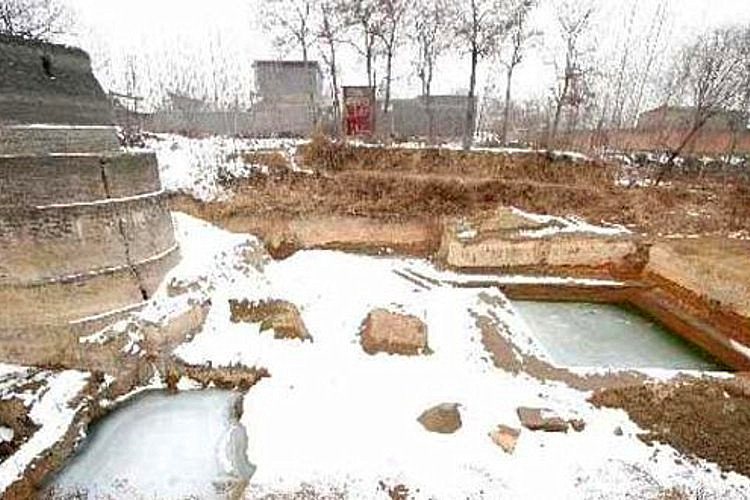
Maludong Paleolithic Site in Mengzi City, Honghe
Overview
The Maludong Paleolithic Site is a significant archaeological location situated at the foothills of Huangjiashan (黄家山), approximately 7 kilometers south of Mengzi County (蒙自县). This site is classified as a Paleolithic cave, holding crucial evidence of early human life in the region.
Historical Significance
The cave was discovered in 1989 during a local quarrying operation. Initial excavations revealed a wealth of cultural artifacts, including human skulls, teeth fossils, stone tools, and bone implements. Notably, evidence of fire usage was found, with layers of ash and charcoal, indicating that humans inhabited this site around 10,000 years ago. In recognition of its archaeological importance, the site was designated as a cultural heritage protection unit by Honghe Hani and Yi Autonomous Prefecture (红河哈尼族彝族自治州) in 1991.
During the Paleolithic era, the landscape of the Mengzi Basin (蒙自坝) was vastly different, featuring a large, shimmering lake that supported a diverse ecosystem rich in marine flora and fauna. The surrounding primordial forests provided ample resources, creating a suitable habitat for early human settlers.
Archaeological Findings
The Maludong site is characterized by its cave entrance, which faces east and measures 8.2 meters in width, 9.5 meters in height, and 3 meters in depth. The entrance is approximately 15 meters above the ancient lake level, opening toward the southwest. Radiocarbon dating conducted by the Yunnan Seismological Bureau (云南省地震局) confirms that the site dates back to the Late Paleolithic period, over 10,000 years ago.
Artifacts Discovered
- Human Fossils: Included skulls, jaws, femurs, and teeth, with a particularly notable complete skull fossil.
- Stone Tools: Various implements indicative of hunting and gathering activities.
- Bone Artifacts: Items made from animal bones, reflecting the diet and lifestyle of the inhabitants.
- Ash and Charcoal: Evidence of fire usage, suggesting that these early humans had mastered cooking and possibly tool-making techniques.
The significant presence of deer bones among the artifacts indicates that these ancient inhabitants relied heavily on hunting large game, leading to the cave’s name, “Maludong” (马鹿洞), which translates to “Deer Cave.”
Importance of the Findings
The archaeological discoveries at Maludong are vital in understanding the early human presence in Yunnan Province. They provide concrete evidence that humans occupied this region more than 10,000 years ago, contributing to the broader narrative of human evolution and migration in East Asia. This site plays a crucial role in filling gaps in the archaeological record of the Honghe Valley, showcasing the region’s rich historical heritage.
Archaeological Impact
The Maludong site is one of the best-preserved ancient human habitation sites in Yunnan, shedding light on the lifestyle, diet, and social structure of early humans in the area. The findings have pushed back the recorded history of Mengzi by over 10,000 years, establishing the region’s significance in the development of human civilization.
Protection Status
Following the completion of excavations in 1989, the Maludong site was refilled to preserve its integrity. The designated protection area encompasses:
- East: 130 meters to the rear canal
- West: 72 meters to the main road
- South: 120 meters to Boundary Marker No. 5
- North: 100 meters to the quarry road
The total protected area measures 44,440 square meters. A monument marking the “Maludong Site” stands at the foot of Huangjiashan, serving as a reminder of its historical significance.
How to Get There
To visit the Maludong Paleolithic Site:
- Travel to Mengzi City: You can reach Mengzi from Kunming (昆明) by bus or train. The journey typically takes around 3 to 4 hours.
- Local Transport: From Mengzi, take a taxi or use local public transport to get to Huangjiashan, where the site is located. Ensure you confirm the driver knows the destination, as it may not be well-marked.
Travel Tips
- Timing: Plan your visit during daylight hours for optimal visibility and safety.
- Footwear: Wear comfortable shoes suitable for walking, as the terrain may be uneven and require some hiking.
- Supplies: Bring water and snacks, as facilities near the site may be limited.
- Guided Tours: Consider hiring a local guide to gain deeper insights into the site’s history and the significance of the artifacts discovered.
- Photography: Capture the natural beauty of the area, but be respectful of archaeological regulations regarding photography of the site.
- Respect the Site: Follow all guidelines and respect the protected status of the site to preserve its integrity for future generations.


 7 Days GolfingTour
7 Days GolfingTour
 8 Days Group Tour
8 Days Group Tour
 8 Days Yunnan Tour
8 Days Yunnan Tour
 7 Days Shangri La Hiking
7 Days Shangri La Hiking
 11 Days Yunnan Tour
11 Days Yunnan Tour
 6 Days Yuanyang Terraces
6 Days Yuanyang Terraces
 11 Days Yunnan Tour
11 Days Yunnan Tour
 8 Days South Yunnan
8 Days South Yunnan
 7 Days Tea Tour
7 Days Tea Tour
 8 Days Muslim Tour
8 Days Muslim Tour
 12 Days Self-Driving
12 Days Self-Driving
 4 Days Haba Climbing
4 Days Haba Climbing
 Tiger Leaping Gorge
Tiger Leaping Gorge
 Stone Forest
Stone Forest
 Yunnan-Tibet
Yunnan-Tibet
 Hani Rice Terraces
Hani Rice Terraces
 Kunming
Kunming
 Lijiang
Lijiang
 Shangri-la
Shangri-la
 Dali
Dali
 XishuangBanna
XishuangBanna
 Honghe
Honghe
 Kunming
Kunming
 Lijiang
Lijiang
 Shangri-la
Shangri-la
 Yuanyang Rice Terraces
Yuanyang Rice Terraces
 Nujiang
Nujiang
 XishuangBanna
XishuangBanna
 Spring City Golf
Spring City Golf
 Snow Mountain Golf
Snow Mountain Golf
 Stone Mountain Golf
Stone Mountain Golf



















